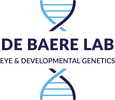|
Inherited retinal diseases (IRD) cause early-onset blindness, impacting over two million individuals globally. These monogenic disorders exhibit significant clinical and genetic heterogeneity, with over 260 identified disease genes. Variants in coding regions explain 50-70% of cases. Whole exome and genome sequencing studies have not unveiled many new disease genes, suggesting noncoding regions may harbor missing variants. Identifying genetic defects and underlying pathways is crucial for advancing gene therapy, now entering clinical application for various IRD subtypes.
|
Genetic developmental disorders typically result from variants in the coding part of the genome. However, various other mechanisms can impair normal gene function. Especially in development-related genes, precise expression is crucial and guided by the regulatory code of the genome, which remains not fully understood. Studying specific genetic disorders has been instrumental in revealing disruptions to this regulatory code, known as "cis-ruptions".
|
De Baere Lab © 2024

